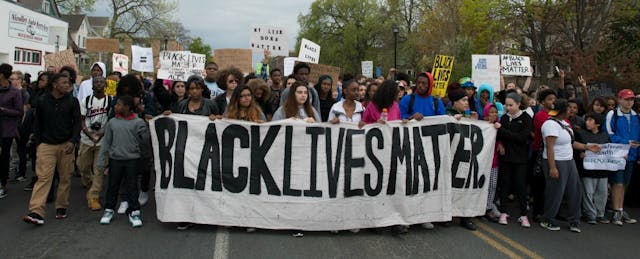Two years ago Marcia Chatelain, an associate history professor at Georgetown University, learned that Michael Brown would not get to start his first day of college. Heartbroken by Brown’s death at the hands of police officers in Ferguson, MO, she took to Twitter. Chatelain asked educators to commit to talking with their students on the first day of class about what had happened, and #FergusonSyllabus was born.
The idea was simple: share a piece of media—a book, song, video, piece of artwork—that spoke to some aspect of Ferguson to help educators teach about the national crisis. Teachers in K-12 and higher education latched on and shared responses, ranging from Malcolm X’s autobiography to author Chimamanda Ngozi Adichie’s TED Talk, “The Danger of a Single Story.”
Fast-forward two summers, and the national sentiment is eerily similar. Philando Castile and Alton Sterling’s deaths and the shootings of police officers in Dallas and Baton Rouge have left the public outraged, confused and saddened. As students set foot on campus this fall, faculty and administrators will grapple with how to address the social justice issues affecting their communities.
Colleges often seem like bastions of activism for social justice issues. Earlier this month, students at the University of Oregon marched to protest the killing of black men by police officers. But for faculty and administrators, engaging in these issues can be taboo. “Professors are sometimes really cautious about engaging difficult topics, because they think they can get caught up in a political machinery that tries to penalize them for that,” Chatelain says. This leads to the public perception that there’s a huge disconnect between what professors do and what happens in the world.
Since Chatelain’s call to arms, a Twitter syllabus “has become a shorthand for a way for thinking about intellectual engagement in social problems,” she says. There’s #CharlestonSyllabus and #BlackLivesMatterSyllabus, both spaces where academics share ideas for talking about race and inequity in their classes. “These syllabi projects show just how relevant our research is and how relevant our presence is in moments of crisis. It helps educators know and remind them that they have a place in these moments,” Chatelain says.
Important conversations about social justice issues aren’t confined to history or social studies classes, either. “All hands are on deck to really think about the pervasive impact of racism and inequality on everyone,” Chatelain adds. Since #FergusonSyllabus, she’s seen a computer science faculty member have students track analytics on trending Twitter topics as a way to address issues of race and inequity in the context of their disciplines; in another class, a chemistry professor talks about tear gas with her students.
On some campuses, the conversation is more direct. At New York University, Frank Leon Roberts is currently teaching a Black Lives Matter course. The entire syllabus is available online, and it includes readings from Cornel West’s books to Lauryn Hill’s “Black Rage” music video.
Conversations about inequity are happening outside of class, too. John Sygielski, president of Harrisburg Area Community College in Pennsylvania, uses the #blacklivesmatter hashtag on Twitter and Facebook, where he actively comments on social justice issues.
He’s shared quotes from Martin Luther King, Junior, tweeted: “Amen! @POTUS - Police #shootings should trouble all Americans,” and tweeted an image sent to him by a friend with the words “I can’t keep calm I have a black son.”
It’s an unusual move for a college president, especially a white male, to voice personal opinions on race, but Sygielski says it’s part of his job. “My role as a college president is to be reflective of the community that I work in, that I live in. It’s my job to be able to facilitate honest, sometimes disruptive conversations that are going to help other people like me, community leaders, start to rethink their bias and their prejudice.”
Sygielski says that faculty and HACC’s board of trustees are, for the most part, supportive. Educators have asked him for recommendations for articles to post “to move the conversation forward.”
His actions have not received unequivocal support. One community member outright told him it was not right to engage with the Black Lives Matter movement. Others have more gently questioned whether he should engage in public discussions about race, suggesting he stick to academics.
Sygielski disagrees. He says “the presidency for a college or university now is a lot different now than it was five, 10, 15 years ago. We are at a point in our life cycle now where these conversations need to be center. We can no longer be dysfunctional and ignore them or pretend they’re not issues.”
Bill Boulding, dean of Duke University’s Fuqua School of Business, recently wrote an open letter encouraging students, staff and faculty to get outside of their bubbles and engage with people who vehemently disagree with them on social issues. “Otherwise, well-intentioned conversations we may be having about diversity and inclusion will be happening in the echo chamber of people who share our founding assumptions,” he wrote.
Talk is cheap, but the goal of these conversations on campus and beyond is to spur action, Sygielski says. “[College presidents] do a great job of philosophizing, but we need to do a better job of talking about what we’re going to do in three months or six months.”
At Georgetown, Chatelain keeps an eye on the #FergusonSyllabus, which continues to draw comments from the academic community two years later. “Twitter provides a larger platform for people to come closer to our ideas and our research,” she says. But she stresses that colleges need to make it easier to talk about social justice issues even when there’s not a tragic event to rally around.
“It’s important that we teach our educational institutions to engage in these issues all the time—that we don’t wait for crises,” she says. “We need to normalize talking about race and thinking about these issues in moments where the temperature is hot and cold and in-between.”


